
East Liberty Presbyterian Church, sometimes referred to as the Cathedral of Hope, is in the East Liberty neighborhood of the East End of Pittsburgh, Pennsylvania, United States. The current building is the fifth church building to occupy the site; the first was in 1819.
Broadway United Church of Christ is a Congregationalist Church located on West 71st Street, between Amsterdam Avenue and Columbus Avenue on the Upper West Side of Manhattan.
Briarwood Presbyterian Church is a congregation of the Presbyterian Church in America located in suburban Birmingham, Alabama.

Hunter Street Baptist Church is a Baptist Church located in Hoover, Alabama, a suburb of Birmingham. It is affiliated with the Southern Baptist Convention.

Brown Memorial Park Avenue Presbyterian Church of Baltimore, Maryland, U.S., is a large, Gothic Revival-style church built in 1870 and located at Park Avenue and Lafayette Avenue in the city's Bolton Hill neighborhood. Named in memory of a 19th-century Baltimore financier, the ornate church is noted for its exquisite stained glass windows by artist Louis Comfort Tiffany, soaring vaulted ceiling, and the people associated with its history. Maltbie Babcock, who was the church's pastor 1887–1900, wrote the hymn This is My Father's World. Concert performer Virgil Fox was organist at Brown Memorial early in his career (1936–1946).

Coral Ridge Presbyterian Church is a Christian church within the Presbyterian Church in America located in Fort Lauderdale, Florida. It was founded in 1960 by D. James Kennedy (1930–2007), who served as the church's senior pastor until shortly before his death.

The National Presbyterian Church is a Christian congregation of approximately 1,500 members of all ages from the greater metropolitan Washington, D.C., area. The mission statement of the church is "Leading People to Become Faithful Followers of Jesus Christ Together in God's World"

Fifth Avenue Presbyterian Church is a Presbyterian Church (U.S.A.) church in New York City. The church, on Fifth Avenue at 7 West 55th Street in Midtown Manhattan, has approximately 2,200 members and is one of the larger PCUSA congregations. The church, founded in 1808 as the Cedar Street Presbyterian Church, has been at this site since 1875.

Bethany Independent-Presbyterian Church (IPC) is an independent church located between the Paya Lebar and Serangoon areas of central Singapore. It is the mother church of the IPC Family, which spans Singapore, India, Australia and Myanmar.
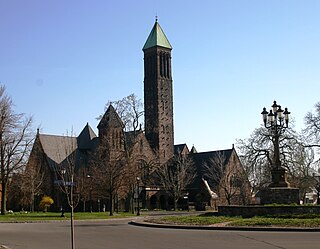
The First Presbyterian Church in Buffalo, New York was the first organized religious body formed in what was then the western frontier of New York State. The town of Buffalo was sparsely populated when the church was organized on February 2, 1812. However, having survived the War of 1812, the town of Buffalo was rebuilt and rapidly grew with the completion of the Erie Canal in 1825. The first two buildings were located on the same downtown lot. However, the congregation relocated between 1889 and 1891 to its present location approximately one and-a-half miles to the north in a more residential area.

Historic First Bryan Baptist Church is an African-American church that was organized in Savannah, Georgia, by Andrew Bryan in 1788. Considered to be the Mother Church of Black Baptists, the site was purchased in 1793 by Bryan, a former slave who had also purchased his freedom. The first structure was erected there in 1794. By 1800 the congregation was large enough to split: those at Bryan Street took the name of First African Baptist Church, and Second and Third African Baptist churches were also established. The current sanctuary of First Bryan Baptist Church was constructed in 1873.
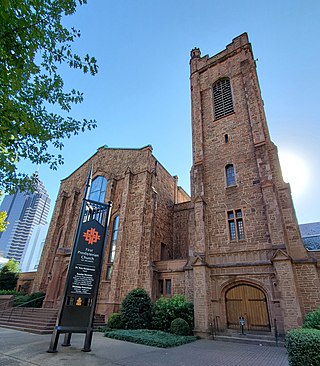
First Presbyterian Church of Atlanta is a congregation of the Presbyterian Church (U.S.A.) located in the Midtown section of Atlanta, Georgia. First Presbyterian Church was founded in 1848, and it was Atlanta's first Presbyterian house of worship. The original church building on Marietta Street was vacated in April 1916 and the property was sold to the U.S. government for the construction of the headquarters of the Federal Reserve Bank of Atlanta. The current church building on Peachtree Street was listed on the National Register of Historic Places in 2020.

The Old Presbyterian Meeting House is a Christian church located at 321 South Fairfax Street in the Old Town neighborhood of Alexandria, Virginia. It is part of the National Capital Presbytery and the Synod of the Mid-Atlantic of the Presbyterian Church (USA).

Temple Emanu-El, is a Reform Jewish congregation and synagogue, located at 2100 Highland Avenue South, in Birmingham, Alabama, in the United States.
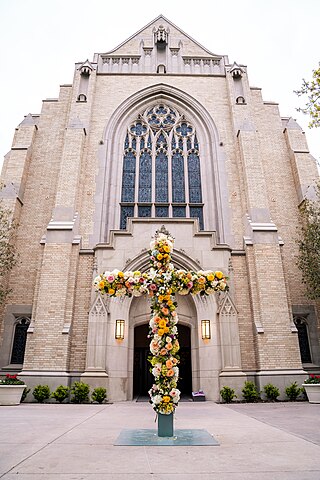
Highland Park Presbyterian Church is a Presbyterian church in University Park, Texas, with a Dallas post office address. In 2013, HP Pres voted to change its affiliation from Presbyterian Church (U.S.A.) to ECO: A Covenant Order of Evangelical Presbyterians.
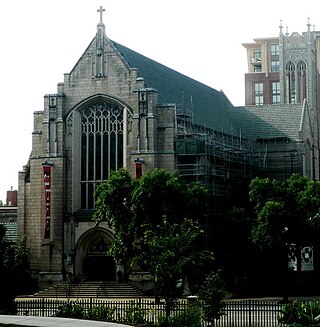
Luther Memorial Church is a Lutheran congregation at 1021 University Avenue in Madison, Wisconsin in the United States. A member of the Evangelical Lutheran Church in America (ELCA), it is known for its worship, music, education, social ministry and preschool programs. The congregation's cathedral-like Neogothic-style building, designed by local architects Claude & Starck and built in 1923, was added to the National Register of Historic Places in 2018.

The Church of the Pilgrims is a Presbyterian Church (USA) congregation located in Washington, D.C., in the United States. The congregation was founded in 1903 as the Second Southern Presbyterian Church and took its current name in 1919. The congregation resides in a Gothic Revival church located at 22nd Street NW and P Street NW. The building was designed by architect Benjamin C. Flournoy of Baltimore, Maryland, and completed in March 1929.
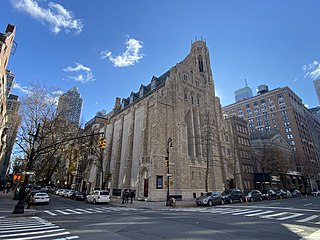
Central Presbyterian Church is a historic congregation on the Upper East Side of Manhattan in New York City, founded by pastor and abolitionist William Patton in 1821. It is a member of the Evangelical Presbyterian Church, and it worships in a Gothic Revival structure completed in 1922 that was originally commissioned and largely funded by John D. Rockefeller Jr. as Park Avenue Baptist Church.
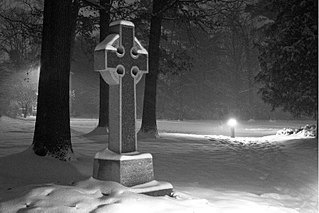
Bon Air Presbyterian Church (PCUSA), which began in 1884, is an historic Presbyterian church and preschool located on Huguenot Road in Bon Air, Virginia, a census-designated place (CDP) in Chesterfield County, Virginia, in the United States. The church and its location are thought to be named after the French term for "good air". The name choice may have been influenced by the 18th century settlement in the region of religious refugee French Huguenots and by the later popularity of the settlement as a summer resort and park accessible by streetcar from Richmond. Bon Air Presbyterian Church first began worshiping in a little Victorian Gothic building known as the “Union Chapel", located on Buford Road, south of the James River in the Southside of Richmond. "Union Chapel" served the Bon Air Presbyterian congregation until 1963. The number of members grew, and a new church building was erected at 9201 West Huguenot Road in North Chesterfield, Virginia to meet the needs of the larger congregation.
Morris Newfield was a Hungarian-born American rabbi from Alabama.



















